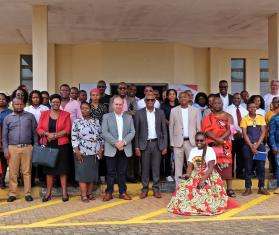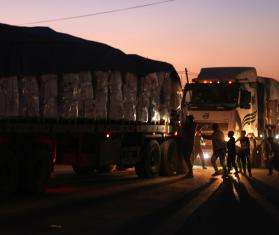An estimated 200,000 people living in terrible sanitary conditions in Afgooye; Mortality and health indicators largely above emergency thresholds
Afgooye, Somalia/Geneva, December 11, 2007—Increased fighting inside Somalia’s capital, Mogadishu, has led to another exodus of the population, adding to hundreds of thousands of internally displaced people (IDPs) who have already fled the conflict area since January 2007.
West of Mogadishu, on the road to Afgooye, where Doctors Without Borders/Médecins Sans Frontières (MSF) has been providing emergency medical and nutritional care since April 2007, the number of IDPs has nearly doubled in just a few weeks, reaching an estimated 200,000 people, according to the UNHCR. Most live by the roadside, under makeshift shelters, and are fully dependent on external assistance.
The population is facing unacceptable sanitary conditions and their vulnerability has only increased in the face of months-long food shortages. In Afgooye and Hawa Abdi, a large majority of the 1,700 weekly medical consultations carried out by MSF teams are linked to precarious living conditions: severe malnutrition, diarrhea, and acute respiratory tract infections.
Children arriving from Mogadishu today, especially those under five years of age, are extremely weak. In the past two weeks, more than 250 severely malnourished children, including 80 who had to be hospitalized in intensive care, were admitted to MSF feeding centers. Faced with this deteriorating situation, MSF teams have doubled their capacity from 20 to 40 beds in Afgooye, and are setting up a 50-bed pediatric unit in Hawa Abdi. The intensive nutritional care center in Hawa Abdi has increased its capacity from 20 beds in September to 80 today, and needs are increasing by the day.
Mortality rates are extremely worrying. In Hawa Abdi, a camp with 32,000 IDPs, where some humanitarian efforts are ongoing, the mortality rate of children under five is more than twice the emergency threshold: 4.2 deaths per 10,000 people per day. The global mortality rate is 2.3 deaths per 10,000 people per day, according to a retrospective mortality survey conducted by MSF between September 12 and November 23. Diarrhea is the main cause of death in the camp (over 50 percent) due to disastrous sanitary conditions.
Needs for water, food, shelter, and medical care are rapidly increasing. However, increasing humanitarian assistance is extremely difficult in this conflict. Despite the mobilization of international aid over the past weeks, it is still largely inadequate. Living conditions in the estimated 100 improvised camps along the Mogadishu-Afgooye axis are significantly below commonly accepted standards for emergency humanitarian assistance, and the risk of epidemic outbreaks is high.
The number of IDPs is increasing every day. Without a significant increase in neutral and independent assistance, this emergency situation could deteriorate even further.
MSF has worked continuously in southern and central Somalia for over sixteen years and is currently providing medical care in nine regions - Bakool, Bay, Galgadud, Hiraan, Lower Juba, Middle Juba, Mudug, Middle Shabelle and Lower Shabelle. MSF today has approximately 60 international staff and over 800 national staff working in Somalia.



